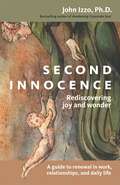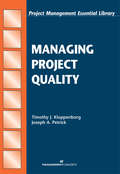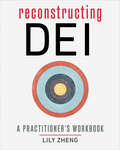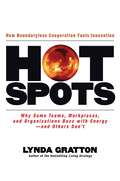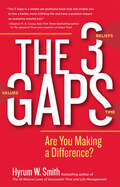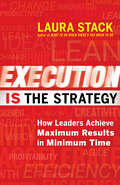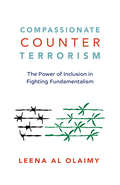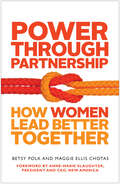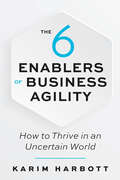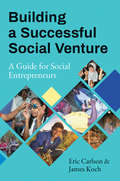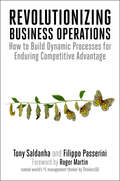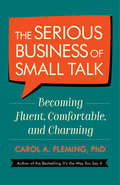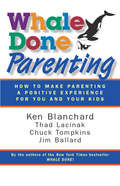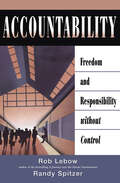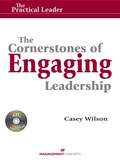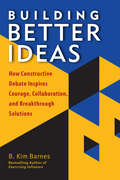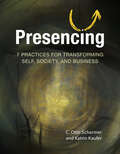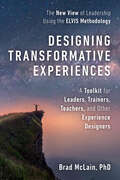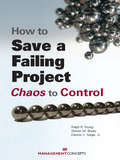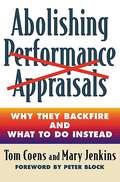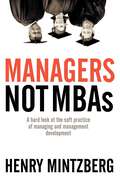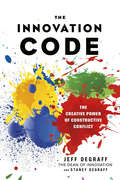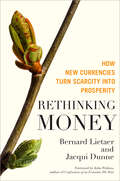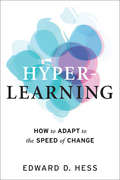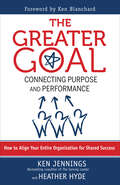- Table View
- List View
Second Innocence: Rediscovering Joy and Wonder; A Guide to Renewal in Work Relati Ons and Daily Life
by John B. Izzo"What might happen," John Izzo writes, "if we began to think of innocence as a quality we bring to our lives, a perspective and a way of looking at the world, which is not replaced by experience but which influences our experience? When we choose innocence as a frame to experience the world, the qualities of hope, idealism, openness, and faith nurture the experience of wonder and joy in our lives." In the tradition of Robert Fulgham and Richard Carlson, Izzo uses his experiences as a son, husband, father, employee, minister, author and corporate speaker to inspire readers to see the world from this new, rejuvenating perspective. Chapters with titles like Full Speed Ahead In The Wrong Direction, Choose Your Glasses Carefully, Getting Past Your Expiration Date, The Burned-Out Buddha and The Power of Not Now explore how to reclaim our innocence in four realms --- daily life, faith, work, and relationships. "It is not that experience should not shape our idealism", Izzo tells us. "In fact, our initial innocence must be shaped by our experiences. To hold on to our innocence is a life long process and it is our ability to foster the quality of innocence that continues to bring us to the edge of what is possible in our lives and in our communities. That we may choose innocence and idealism while incorporating the harder experiences of living is the core premise of this book." Both practical and inspiring, Second Innocence combines wonderful stories with an inspiring philosophy to help us maintain our idealism and enthusiasm throughout our lives.
Managing Project Quality
by Timothy J. Kloppenborg PhD Joseph A. Petrick PhD, SPHRMake breakthroughs in project quality by combining project management with quality management - this books shows you how. Guiding you from project initiation through closure, the book provides a detailed stage-specific flowchart of activities correlated with appropriate tools to give you new power to meet customer expectations and institutionalize project quality.
Reconstructing DEI: A Practitioner's Workbook
by Lily ZhengAuthor of the bestselling DEI Deconstructed returns with a companion workbook filled with practical and actionable techniques for changemakers at all stages of their DEI journey.The next step in your DEI journey starts here. Building on the knowledge base of DEI Deconstructed, Lily Zheng offers a workbook with 40 original exercises, worksheets, and other tools to help guide you and your organization toward more substantive and lasting DEI outcomes. Whether you're a new or veteran DEI practitioner looking to improve your practice, a leader looking to grow your leadership skills, or an advocate looking to play more powerful roles in movements, this book will give you the practical tools to do just that. From self-work to organizational change, this workbook will upskill you with the core competencies required for impactful DEI work, such as diagnosing inequity, working with constituents, building movements, creating psychological safety, stewarding inclusive cultures, resolving conflict and harm, and achieving systems change. Most importantly, it will give you valuable experience putting these skills into action. Each activity can stand on its own and is designed to stimulate valuable reflection and practice. Included are recommendations for targeted exercise roadmaps to supplement your learning journey. Taken all together, these exercises are a complete masterclass in any practitioner's DEI education.
Hot Spots: Why Some Teams, Workplaces, and Organizations Buzz with Energy - And Others Don't
by Lynda GrattonYou always know when you are in a Hot Spot. You feel energized and vibrantly alive. Your brain is buzzing with ideas, and the people around you share your joy and excitement. Things you've always known become clearer, adding value becomes more possible. Ideas and insights from others miraculously combine with your own to create new thinking and innovation. When Hot Spots arise in and between companies, they provide energy for exploiting and applying knowledge that is already known and genuinely exploring what was previously unknown. Hot Spots are marvelous creators of value for organizations and wonderful, life-enhancing phenomena for each of us. Lynda Gratton has spent more than ten years investigating Hot Spots--discovering how they emerge and how organizations can create environments where they will proliferate and thrive. She has studied dozens of companies and talked to hundreds of employees, managers, and executives in the US, Europe, and Asia. She has asked the important questions: Why and when do Hot Spots emerge? What is it about certain groups of people that support the emergence of Hot Spots? What role do leaders play? She's discovered a host of elements that together contribute to the emergence of Hot Spots--creating energy and excitement, and supporting and channeling that energy into productive outcomes. In this groundbreaking book, Gratton describes four crucial qualities that an organizational culture must have to support the emergence of Hot Spots, looks at what leaders can do to encourage them, and offers activities and tools you can use in your own company to increase the probability of them arising. In these days when traditional organizational boundaries are becoming barriers to progress, Gratton offers advice and guidance that you can use right now to increase the probability of Hot Spots emerging in your organization.
The 3 Gaps: Are You Making a Difference?
by Hyrum W. SmithFor a Better Life, Close the Gaps!We all want to make a difference. But just as you need to put on your own oxygen mask before helping other passengers on an airplane, getting your own life together is the first step to making a positive impact in the world. Franklin Covey cofounder Hyrum Smith shows that what stops us are gaps between where we are and where we want to be. The first is the Beliefs Gap, between what we believe to be true and what is actually true. The second is the Values Gap, between what we value most in life and what we actually spend our life doing. The third is the Time Gap, between what we plan to do each day and what we actually get done. Smith offers a practical blueprint that we all can use to recognize and close each of these three gaps and illustrates how it can be done through inspiring true stories. The 3 Gaps provides the concepts and the tools needed to establish a solid foundation from which you can help make the world a better place.
Execution IS the Strategy: How Leaders Achieve Maximum Results in Minimum Time
by Laura StackTurn Strategy into Performance! In today’s world of rapid, disruptive change, strategy can’t be separate from execution—it has to emerge from execution. You have to continually adjust your strategy to fit new realities. But if your organization isn’t set up to be fast on its feet, you could easily go the way of Blockbuster or Borders. Laura Stack shows you how to quickly drive strategic initiatives and get great results from your team. Her LEAD Formula outlines the Four Keys to Successful Execution: the ability to Leverage your talent and resources, design an Environment to support an agile culture, create Alignment between strategic priorities and operational activities, and Drive the organization forward quickly. She includes a leadership team assessment, group reading guides, and bonus self-development resources. Stack will equip you with the knowledge, skills, and inspiration to help you hit the ground running!
Compassionate Counterterrorism: The Power of Inclusion In Fighting Fundamentalism
by Leena Al OlaimyFrom purchasing pay-per-view pornography to smoking pot, many so-called Muslim terrorists prove by their actions that they aren't motivated by devotion to religion, Leena Al Olaimy argues. So why do they really turn to violence, and what does that tell us about the most effective way to combat terrorism? Al Olaimy sets the stage by providing a quick, thoughtful grounding in the birth of Islam in a barbaric Game of Thrones–like seventh-century Arabia, the evolution of fundamentalist thought, and the political failures of the postcolonial period. She shows that terrorists are motivated by economic exclusion, lack of opportunity, social marginalization, and political discrimination. This is why using force to counter terrorism is ineffective—it exacerbates the symptoms without treating the cause. Moreover, data shows that military interventions led to the demise of only 12 percent of religious terrorist groups.Combining compelling data with anecdotal evidence, Al Olaimy sheds light on unorthodox and counterintuitive strategies to address social woes that groups like ISIS exploit. For example, she describes how Indonesia, the world's most populous Muslim country, has decreased terrorism while paradoxically becoming more overtly religious. Or how Mechelen, the city with Belgium's largest Muslim population, adopted integration policies so effective that not one of its 20,000 Muslims left to join ISIS. Using religion, neuroscience, farming, and even love, this book offers many inspiring examples and—for once—an optimistic outlook on how we can not just fight but prevent terrorism.
Power Through Partnership: How Women Lead Better Together
by Betsy Polk Maggie Ellis ChotasWINNER OF THE 2015 SILVER MEDAL IPPY AWARD IN BUSINESS/CAREER/SALES. Betsy Polk and Maggie Chotas have learned something powerful: when women work together they discover a level of support, flexibility, confidence, accountability, and freedom to be themselves that they rarely find in other work relationships. Drawing on their own twelve-year partnership and from interviews with 125 women business partners, Polk and Chotas demolish the myths that keep women from collaborating and offer advice for handling a host of potential challenges. This groundbreaking book shows that when women team up—combining complementary skills, channeling their egos into the partnership, and encouraging each other—they can work as full equals to achieve something that's exponentially greater than each woman alone.
The 6 Enablers of Business Agility: How to Thrive in an Uncertain World
by Karim HarbottAdopting the latest agile tools and practices won't be enough to respond to rapid market change. Leaders must first lay the groundwork by creating the right environment for these tools to work. Many managers struggle to install the underlying organizational operating system for business agility. High-performing agile organizations depend on the strength of six key enabling factors: leadership, culture, structure, people, governance, and ways of working. This book explains why these factors are important and how they work together to increase organizational agility. Real-world examples, stories, and tools will help leaders get realistic about the scope of changes needed in their organizations and show them how to get started.Karim Harbott does not offer a book of recipes. Instead, he focuses on mindset, principles, and general patterns. This book summarizes of the most important factors in increasing organizational agility and why they work, which leaders will need to consider in a so-called agile transformation. Because every organization is different, each will have its own route to agility and high performance. Managers will need to tackle all the areas that are crucial to creating an environment in which any chosen approach can work.
Building a Successful Social Venture: A Guide for Social Entrepreneurs
by Eric Carlson James KochThis is the first book on creating and running a social enterprise to combine theoretical discussions with current cases from around the world, filling a huge gap in the literature. It serves as an eminently practical blueprint for those who wish to build, sustain, and grow social ventures. Building a Successful Social Venture draws on Eric Carlson's and James Koch's pioneering work with the Global Social Benefit Institute, cofounded by Koch at Santa Clara University's Miller Center for Social Entrepreneurship. Since 2003, over 200 Silicon Valley executives have mentored more than 800 aspiring social entrepreneurs at the GSBI. It is this unparalleled real-world foundation that truly sets the book apart. Early versions of the book were used in both undergraduate and MBA classes.Part 1 of the book describes the assumptions that the GSBI model is based on: a bottom-up approach to social change, a focus on base-of-the-pyramid markets, and a specific approach to business planning developed by the GSBI. Part 2 presents the seven elements of the GSBI business planning process, and Part 3 lays out the keys to executing it. The book includes "Social Venture Snapshots" illustrating how different organizations have realized elements of the plan, as well as a wealth of checklists and exercises.Social ventures hold enormous promise to solve some of the world's most intractable problems. This book offers a tested framework for students, social entrepreneurs, and field researchers who wish to learn more about the application of business principles and theories of change for advancing social progress and creating a more just world.
Revolutionizing Business Operations: How to Build Dynamic Processes for Enduring Competitive Advantage
by Tony Saldanha Filippo PasseriniDon't risk the dire consequences of your work processes becoming obsolete-discover a powerful model for constant, ongoing, enterprise-wide process evolution and optimization.If you have a great product, but don't have the operations in place to efficiently and effectively support it-production, manufacturing, sales, finance, human resources, etc.-you won't succeed. Product innovation is seen as flashier and so gets far more attention, but you can create an enduring competitive advantage by revolutionizing business operations. The problem is most attempts to improve business operations are reactive, sporadic, and siloed. Tony Saldanha and Filippo Passerini's Dynamic Process Transformation model provides a living model for constant, ongoing process evolution and optimization. The authors focus on maximizing three drivers of change. First, open market rules-each business process must be run as a separate business, instead of via monolithic mandates coming down from on high. Second, there must be unified accountability- outcomes must be clear and consistent across the company, instead of being siloed within departments. And third, there needs to be a dynamic operating engine, a methodology to convert the constantly changing business process goals into tactical day-to-day employee actions.With numerous examples from leading companies, this book shows how to proactively keep business processes across the company from becoming obsolete and take advantage of a neglected key to success.
The Serious Business of Small Talk: Becoming Fluent, Comfortable, and Charming
by Carol FlemingSmall Talk Is the Single Most Important Communication Skill You Can Develop Carol Fleming wants to show you that small talk is not as "small" as you might think. It's the foundation of every relationship, professional and personal. It is the sound of people reaching out to each other, searching for similarities, shared interests, goodwill, connections, and friendship. And it's something we all do every day with people we know. It's just the one little bit about strangers that throws some people off. Graceful social conversation can be learned, even by those requiring the smallest of baby steps.Fleming covers the inner and outer aspects—from the right attitude to how to dress, move around, and introduce yourself. Most importantly, she lays out a series of simple, memorable conversational strategies that make it easy to go from "Nice weather we're having" to a genuine, rewarding give-and-take. But she won't tell you what to say. Believe it or not, you already have what you need inside you. She merely provides the keys to unlock it. Small talk is the language of welcome, the extension of friendliness, the gracious acknowledgment of others, the kindly exchange of introductions and smiles, and the creation of a safe, courteous social space—and this is what has you terrified? After you read this book, you'll wonder what all the fuss was about.
Whale Done Parenting: How to Make Parenting a Positive Experience for You and Your Kids
by Thad Lacinak Chuck Tompkins Ken BlanchardOffers five simple and effective principles for coping with any parenting challenge • Based on actual killer whale training techniques • Story format makes this an unusual and entertaining approach for a parenting book “How is it they can get a killer whale to urinate on cue, and we can’t get our son to pee into the toilet?” Most parents feel frustrated with their children from time to time, but killer whale trainer-in-training Amy Sheldrake has a unique perspective. She marvels at the complex behaviors her superiors are able to coax out of these enormous beasts, while she and her husband struggle to make their beloved – and much smaller – son Josh obey what seem like the simplest rules. What does training killer whales have to do with raising children? As this engrossing and unique parenting fable shows, more than you’d think. In their New York Times bestseller Whale Done, Ken Blanchard and his coauthors – including two veteran marine mammal trainers – showed how positive training concepts used at places like SeaWorld could be adapted to the workplace. In this new book they apply these same principles to parenting. Once Amy and Matt get the hang of the five Whale Done principles, they see a dramatic difference in overcoming challenges like following bedtime routines, dealing with tantrums, introducing new foods, sharing, avoiding overuse of the word no, learning to care for a pet, and instituting time-outs. The foundation of the Whale Done approach is respect. It emphasizes communication and praise rather than obedience and punishment – this is not some Pavlovian primer. Whale Done is much more than a set of techniques; it is a way of looking at people and seeing the best that is in them. Great leaders, saints, and sages have developed this skill. Since most of us are less advanced than those paragons, this book can serve as a guide for how to bring out the best in our children.
Accountability: Freedom and Responsibility Without Control
by Randy Spitzer Robert LebowUsing a wealth of real-world examples, this breakthrough book offers a new freedom-based management paradigm that radically improves every aspect of business-from how we hire, compensate, and motivate people to how we address quality issues, serve customers, review employees, and more. Accountability tells the story of Pete Williams, a hard-charging CEO, who meets Stan "Kip" Kiplinger, a retired businessman, during a cross-country train trip. Pete's manufacturing business is in critical condition; productivity is falling. He's tried all the popular management approaches, but he can't get his people to be accountable for meeting their goals. Kip points out that every management system Pete has used is ultimately based on controlling people. Rather than encouraging people to be accountable, control-based systems discourage accountability by destroying people's sense of ownership of their job. Kip introduces Pete to a new way of leading people based on freedom-giving people the freedom to make their own choices and to do it their way. This doesn't mean anarchy; it means leadership expects everyone to act like an adult and take responsibility for his or her actions and their outcomes. Accountability details how this new approach yields a consistent flow of creative innovations and organizational improvements impossible under the old, coercive systems.
The Cornerstones of Engaging Leadership
by Casey WilsonIn the 21st Century, people are the competitive advantage. The talent and level of dedication of an organization's workforce make the difference in achieving success. The traditional command-oriented leadership style is not enough to keep today's employees motivated—they need to be engaged. They need passion, connection, and inspiration, and a willingness to put forth their best efforts to benefit themselves and their organization. The Cornerstones of Engaging Leadership connects what we know about engagement on an organizational level to what an individual leader can do to increase engagement. Using real-world examples, Wilson reveals the key actions leaders must take to connect with and engage others: •Build trust•Leverage unique motivators•Manage performance from a people-centric perspective•Engage emotions By committing to these four cornerstones of engaging leadership, leaders can unleash the potential of others and inspire effective performance. Through practice tools and exercises, readers are challenged to explore, reflect upon, and apply key concepts and techniques of the engaging leader approach.
Building Better Ideas: How Constructive Debate Inspires Courage, Collaboration, and Breakthrough Solutions
by B. Kim BarnesWhy do teams settle for bad ideas or kill good ones? Popular consultant B. Kim Barnes's unique process of constructive debate shows how teams can create better ideas and outcomes by eliminating obstacles to honest discussion, creativity, and collaboration. In too many organizations, great ideas and unusual solutions can be suppressed, ignored, or attacked. Departments defend their turf, and people choose what is safe over what is better. Bad ideas move forward and good ideas die, which can lead to disastrous results—financial or otherwise. Luckily, there is a workable path out of this dysfunction. Kim Barnes's process of constructive debate shows how to establish conditions that encourage the free exchange, discussion, and development of ideas and eliminate conditions that prevent potentially useful ideas from getting heard. By using this tested model, any company or team can improve outcomes and bring out everyone's best ideas.A constructive debate is one in which a diverse group of individuals can express their ideas, engage others in building on and improving them, explore ideas deeply, and challenge one another's positions in a fair and productive way. In this book, you'll learn a set of behaviors you can model and encourage and a process you can facilitate, lead, or support your client in leading. In this time, where opinions can be tribal and differences can lead to unconstructive conflict, it's important to find ways to build robust ideas through a thoughtful, fair, and inclusive approach.
Presencing: 7 Practices for Transforming Self, Society, and Business
by C. Otto Scharmer Katrin KauferA revolutionary guide to catalyzing multi-system change and planetary healing.Experience 7 practices combined with powerful frameworks to create a more integrated and conscious future from the bestselling author of Theory U.We are living in a time of unprecedented crisis and breakdown. But amid the chaos, small "islands of coherence" are emerging-localized pockets of pioneering thought leaders taking action to begin to catalyze multi-system transformation.Incorporating proven frameworks like Social Fields and the Collective Evolutionary Mirror, the authors share transformative real-world stories of these islands of coherence from the frontlines of change across the globe. You'll go inside the experiences of paradigm-shifting change makers and gain powerful practices for sensing and actualizing the future that wants to emerge.This book outlines 7 critical contributions for elevating our civilization including:•becoming aware•generative listening•dialogue and co-sensing•presencing•ecosystem leadership•co-creating across boundaries•build unityWith this holistic guide, you'll discover how your local actions can cascade into a planetary movement for human and ecological flourishing. The next renaissance is emergent-be a part of birthing it into reality.
Designing Transformative Experiences: A Toolkit for Leaders, Trainers, Teachers, and other Experience Designers
by Brad McLainOffering a new lens on leadership and living, this research-based guide shows how to design experiences that can touch hearts, provoke minds, and change lives in powerful ways.Transformative experiences are life events that change our sense of self in important ways. How do they work? What elements do they require? How can we learn to design them intentionally?By embracing the research-based approach of ELVIS (the Experiential Learning Variables and Indicators System), this book details how to recast yourself as an Experience Design Leader, one that can provide those in your organization with the opportunities needed to reflect and grow as individuals.Beginning with the ELVIS Framework, you will gain deep foundational insight into how transformative experiences work. And then with the ELVIS Toolkit, which includes seven practical design elements, you will have the key to unlocking these powerful experiences for yourself and others.Whether you are new to the idea of designing experiences for others or are a seasoned veteran, ELVIS shows you how to tap into the psychology operating behind the most powerful and important experiences of our lives-those that shape who we are.
How to Save a Failing Project: Chaos to Control
by Dennis C. Nagle Ralph R. Young DBA Steve M. Brady PMPYou CAN Turn Around A Failing Project!Poor project results are all too common and result in dissatisfied customers, users, and project staff. With countless people, goals, objectives, expectations, budgets, schedules, deliverables, and deadlines to consider, it can be difficult to keep projects in focus and on track. How to Save a Failing Project: Chaos to Control arms project managers with the tools and techniques needed to address these project challenges. The authors provide guidance to develop a project plan, establish a schedule for execution, identify project tracking mechanisms, and implement turnaround methods to avoid failure and regain control.With this valuable resource you will be able to:• Identify key factors leading to failure• Learn how to recover a failing project and minimize future risk• Better analyze your project by defining proper business objectives and goals• Gain insight on industry best practices for planning
Abolishing Performance Appraisals: Why They Backfire and What to Do Instead
by Mary Jenkins Tom CoensPerformance appraisals are used in the overwhelming majority of workplaces. Yet, most organizations that use appraisal-and a similar percentage of givers and receivers of appraisal-are dissatisfied with the process. Many are beginning to deeply question whether appraisal is necessary and consistent with the work culture espoused by progressive organizations. Abolishing Performance Appraisals provides an insightful, well documented look at the flaws of appraisal-including its destructive, unintended effects-and offers practical guidance to organizations that want to move on to more progressive approaches to coaching, feedback, development, and compensation. While many books prescribe cures for appraisal, this is the first to focus exclusively on eliminating appraisal altogether and creating alternative, non-appraisal approaches based upon progressive and healthier assumptions about people. The authors expose and dispel the widely accepted myths and false assumptions that underlie common management strategies surrounding the five key functions of appraisal-coaching, feedback, development, compensation, and legal documentation. They then offer step-by-step practical guidance on implementing alternative non-appraisal strategies that deliver the objectives of each function. And they suggest ways to give supervisors and managers the freedom to choose for themselves the most effective ways of working with people. Filled with real-life examples, resources, tools, and detailed practical advice, Abolishing Performance Appraisals is an entirely fresh and radically different view of performance appraisal and its functions that will help people start over and discover new and more effective approaches.
Managers Not MBAs: A Hard Look at the Soft Practice of Managing and Management Development
by Henry MintzbergIn this sweeping critique of how managers are educated and how, as a consequence, management is practiced, Henry Mintzberg offers thoughtful and controversial ideas for reforming both."The MBA trains the wrong people in the wrong ways with the wrong consequences," Mintzberg writes. "Using the classroom to help develop people already practicing management is a fine idea, but pretending to create managers out of people who have never managed is a sham."Leaders cannot be created in a classroom. They arise in context. But people who already practice management can significantly improve their effectiveness given the opportunity to learn thoughtfully from their own experience. Mintzberg calls for a more engaging approach to managing and a more reflective approach to management education. He also outlines how business schools can become true schools of management.
The Innovation Code: The Creative Power of Constructive Conflict
by Jeff DeGraff Staney DeGraffThe Innovation CodeThe Creative Power of Constructive ConflictHarmony is sublime in music but deadly to innovation. The only way to create new, hybrid solutions is to clash. Innovation happens when we bring people with contrasting perspectives and complementary areas of expertise together in one room. We innovate best with people who challenge us, not people who agree with us. It sounds like a recipe for chaos and confusion. But in The Innovation Code, Jeff DeGraff, dubbed the "Dean of Innovation," and Staney DeGraff introduce a simple framework to explain the ways different kinds of thinkers and leaders can create constructive conflict in any organization. This positive tension produces ingenious solutions that go far beyond "the best of both worlds." Drawing on their work with nearly half of the Fortune 500 companies, the DeGraffs help you harness the creative energy that arises from opposing viewpoints. They identify four contrasting styles of innovator—the Artist, the Engineer, the Athlete, and the Sage—and include exercises and assessments for building, managing, and embracing the dynamic discord of a team that contains all four. You can also figure out where you fit on the continuum of innovator archetypes. Using vivid examples, The Innovation Code offers four steps to normalize conflict and channel it to develop something completely new. By following these simple steps, you will get breakthrough innovations that are both good for you and your customers. This is a rigorous but highly accessible guide for achieving breakthrough solutions by utilizing the full—and seemingly contradictory—spectrum of innovative thinking.
Rethinking Money: How New Currencies Turn Scarcity into Prosperity
by Jacqui Dunne Bernard LietaerAs the United States struggles and the economies of Europe stagger, we fail to see a way out of this agonizing cycle of repeated financial meltdowns. In fact, there are thousands of ways to solve not only our recurring fiscal crises but our ongoing social and ecological debacles as well. Solutions are already in place where terrible problems once existed. The changes came about not through increased conventional taxation, enlightened self-interest, or government programs but by people simply rethinking the concept of money. With this restructuring, everything changes. In this visionary book, Bernard Lietaer and Jacqui Dunne explore the origins of our current monetary system—built on bank debt and scarcity—revealing the surprising and sometimes shocking ways its unconscious limitations give rise to so many serious problems. But there is hope. The authors present stories of ordinary people and their communities using new money, working in cooperation with national currencies, to strengthen local economies, create work, beautify cities, and provide education—and so much more is possible. These real-world examples are just the tip of the iceberg—over 4,000 cooperative currencies are already in existence. The book provides remedies for challenges faced by governments, businesses, nonprofits, local communities, and even banks. It demystifies a complex and critically important topic and will strike a deep chord with readers eager to find innovative, meaningful solutions that will do far more than restore prosperity—it will provide the framework for an era of sustainable abundance.
Hyper-Learning: How to Adapt to the Speed of Change
by Edward D. Hess"Ed Hess's Hyper-Learning is uniquely practical and is the essential starting point for charting new ways of thinking, living, working, leading, and being fulfilled in our new world." —Gary Roughead, Admiral, US Navy (retired) former Chief of Naval Operations The Digital Age will raise the question of how we humans will stay relevant in the workplace. To stay relevant, we have to be able to excel cognitively, behaviorally, and emotionally in ways that technology can't.Professor Ed Hess believes that requires us to become Hyper-Learners: continuously learning, unlearning, and relearning at the speed of change. To do that, we have to overcome our reflexive ways of being: seeking confirmation of what we believe, emotionally defending our beliefs and our ego, and seeking cohesiveness of our mental models. Hyper-Learning requires a new way of being and a radical new way of working. In Part 1 of this how-to book, Hess takes a practical workbook approach and helps readers create their Hyper-Learning Mindset, choose and embrace their needed Hyper-Learning Behaviors, and adopt their daily Hyper-Learning Practices. In Part 2, Hess focuses on how to humanize the workplace to optimize Hyper-Learning. Featuring case studies of three business leaders and two public companies, this book shows how to harness the power of human emotions, choices, and behaviors to enable the highest levels of human cognitive, emotional, and behavioral performance—individually and organizationally.
The Greater Goal: Connecting Purpose and Performance
by Ken Jennings Heather HydeOne of the most powerful forces on Earth is an organization fully aligned, individual by individual, team by team, to achieve mutual success. In this vivid business story, Ken Jennings and Heather Hyde provide a road map to guide leaders through the process of engaging employees at all levels of the organization to find the deeper meaning and higher purposes of their work. Learning these methods is Alex Beckley, a leader who receives a wake-up call that inspires him to live and lead differently. He discovers how to invite his coworkers to join a cause, not just a company—to commit to a Greater Goal—and lead the process of shared goal achievement. Alex learns the Star Model, a process encompassing five practices that can help you discover and deliver on your own purpose and passions, in alignment with many others, to accomplish something good and great. Come along on the adventure!
